Evaluating a Study on Weight Management in Adolescent Girls: A Report
VerifiedAdded on 2020/11/12
|14
|5998
|299
Report
AI Summary
This report provides a detailed analysis of a study that investigated weight-related problems in adolescent girls, specifically assessing the impact of the 'New Moves' program. The study employed a randomized controlled trial design, involving 356 participants from intervention and control high schools. The report evaluates various aspects of the study, including selection bias, study design, confounding factors, blinding, data collection methods, withdrawals, intervention integrity, and the PICO question. The analysis reveals strengths and weaknesses in the study's methodology, such as the representativeness of the sample, the method of randomization, and the validity and reliability of the data collection tools. The report also considers the percentage of participants receiving the allocated intervention and the potential for unintended interventions. The findings highlight the importance of understanding weight-related issues in adolescent girls and the effectiveness of interventions aimed at addressing these problems, contributing to the broader field of public health and obesity prevention. The analysis considers the study's implications for future research and practice, emphasizing the need for robust study designs and comprehensive data collection methods.
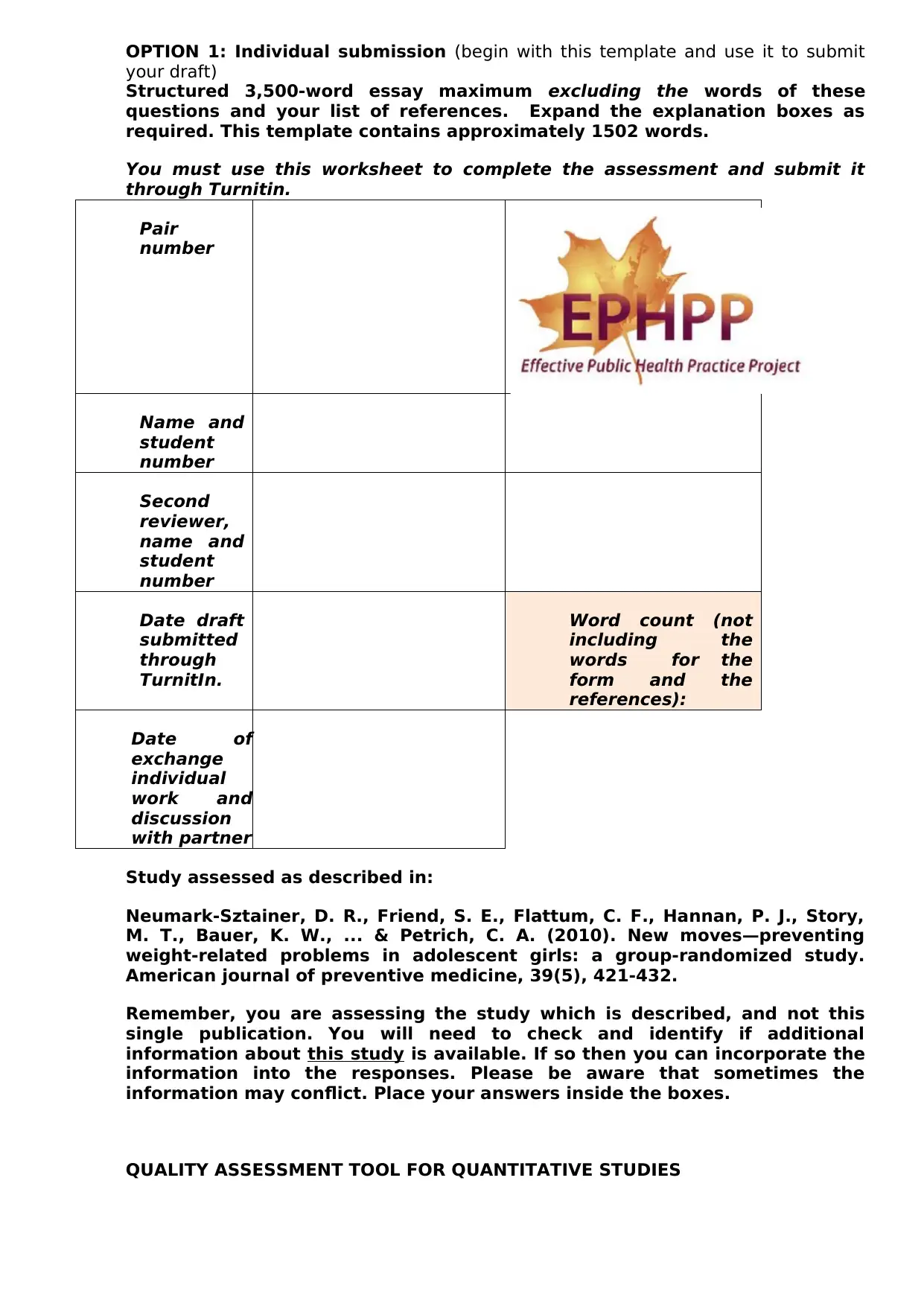
OPTION 1: Individual submission (begin with this template and use it to submit
your draft)
Structured 3,500-word essay maximum excluding the words of these
questions and your list of references. Expand the explanation boxes as
required. This template contains approximately 1502 words.
You must use this worksheet to complete the assessment and submit it
through Turnitin.
Pair
number
Name and
student
number
Second
reviewer,
name and
student
number
Date draft
submitted
through
TurnitIn.
Word count (not
including the
words for the
form and the
references):
Date of
exchange
individual
work and
discussion
with partner
Study assessed as described in:
Neumark-Sztainer, D. R., Friend, S. E., Flattum, C. F., Hannan, P. J., Story,
M. T., Bauer, K. W., ... & Petrich, C. A. (2010). New moves—preventing
weight-related problems in adolescent girls: a group-randomized study.
American journal of preventive medicine, 39(5), 421-432.
Remember, you are assessing the study which is described, and not this
single publication. You will need to check and identify if additional
information about this study is available. If so then you can incorporate the
information into the responses. Please be aware that sometimes the
information may conflict. Place your answers inside the boxes.
QUALITY ASSESSMENT TOOL FOR QUANTITATIVE STUDIES
your draft)
Structured 3,500-word essay maximum excluding the words of these
questions and your list of references. Expand the explanation boxes as
required. This template contains approximately 1502 words.
You must use this worksheet to complete the assessment and submit it
through Turnitin.
Pair
number
Name and
student
number
Second
reviewer,
name and
student
number
Date draft
submitted
through
TurnitIn.
Word count (not
including the
words for the
form and the
references):
Date of
exchange
individual
work and
discussion
with partner
Study assessed as described in:
Neumark-Sztainer, D. R., Friend, S. E., Flattum, C. F., Hannan, P. J., Story,
M. T., Bauer, K. W., ... & Petrich, C. A. (2010). New moves—preventing
weight-related problems in adolescent girls: a group-randomized study.
American journal of preventive medicine, 39(5), 421-432.
Remember, you are assessing the study which is described, and not this
single publication. You will need to check and identify if additional
information about this study is available. If so then you can incorporate the
information into the responses. Please be aware that sometimes the
information may conflict. Place your answers inside the boxes.
QUALITY ASSESSMENT TOOL FOR QUANTITATIVE STUDIES
Paraphrase This Document
Need a fresh take? Get an instant paraphrase of this document with our AI Paraphraser
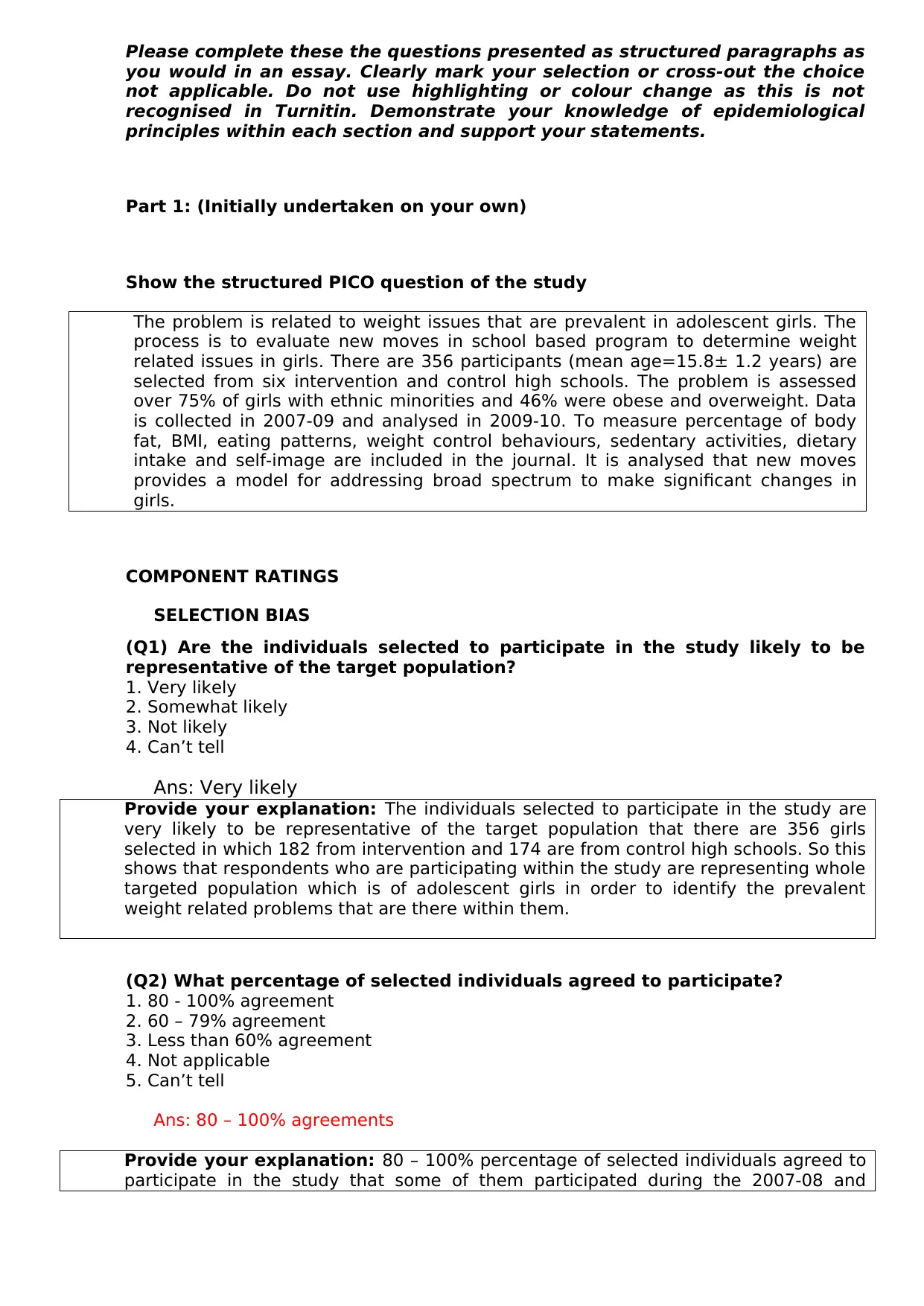
Please complete these the questions presented as structured paragraphs as
you would in an essay. Clearly mark your selection or cross-out the choice
not applicable. Do not use highlighting or colour change as this is not
recognised in Turnitin. Demonstrate your knowledge of epidemiological
principles within each section and support your statements.
Part 1: (Initially undertaken on your own)
Show the structured PICO question of the study
The problem is related to weight issues that are prevalent in adolescent girls. The
process is to evaluate new moves in school based program to determine weight
related issues in girls. There are 356 participants (mean age=15.8± 1.2 years) are
selected from six intervention and control high schools. The problem is assessed
over 75% of girls with ethnic minorities and 46% were obese and overweight. Data
is collected in 2007-09 and analysed in 2009-10. To measure percentage of body
fat, BMI, eating patterns, weight control behaviours, sedentary activities, dietary
intake and self-image are included in the journal. It is analysed that new moves
provides a model for addressing broad spectrum to make significant changes in
girls.
COMPONENT RATINGS
SELECTION BIAS
(Q1) Are the individuals selected to participate in the study likely to be
representative of the target population?
1. Very likely
2. Somewhat likely
3. Not likely
4. Can’t tell
Ans: Very likely
Provide your explanation: The individuals selected to participate in the study are
very likely to be representative of the target population that there are 356 girls
selected in which 182 from intervention and 174 are from control high schools. So this
shows that respondents who are participating within the study are representing whole
targeted population which is of adolescent girls in order to identify the prevalent
weight related problems that are there within them.
(Q2) What percentage of selected individuals agreed to participate?
1. 80 - 100% agreement
2. 60 – 79% agreement
3. Less than 60% agreement
4. Not applicable
5. Can’t tell
Ans: 80 – 100% agreements
Provide your explanation: 80 – 100% percentage of selected individuals agreed to
participate in the study that some of them participated during the 2007-08 and
you would in an essay. Clearly mark your selection or cross-out the choice
not applicable. Do not use highlighting or colour change as this is not
recognised in Turnitin. Demonstrate your knowledge of epidemiological
principles within each section and support your statements.
Part 1: (Initially undertaken on your own)
Show the structured PICO question of the study
The problem is related to weight issues that are prevalent in adolescent girls. The
process is to evaluate new moves in school based program to determine weight
related issues in girls. There are 356 participants (mean age=15.8± 1.2 years) are
selected from six intervention and control high schools. The problem is assessed
over 75% of girls with ethnic minorities and 46% were obese and overweight. Data
is collected in 2007-09 and analysed in 2009-10. To measure percentage of body
fat, BMI, eating patterns, weight control behaviours, sedentary activities, dietary
intake and self-image are included in the journal. It is analysed that new moves
provides a model for addressing broad spectrum to make significant changes in
girls.
COMPONENT RATINGS
SELECTION BIAS
(Q1) Are the individuals selected to participate in the study likely to be
representative of the target population?
1. Very likely
2. Somewhat likely
3. Not likely
4. Can’t tell
Ans: Very likely
Provide your explanation: The individuals selected to participate in the study are
very likely to be representative of the target population that there are 356 girls
selected in which 182 from intervention and 174 are from control high schools. So this
shows that respondents who are participating within the study are representing whole
targeted population which is of adolescent girls in order to identify the prevalent
weight related problems that are there within them.
(Q2) What percentage of selected individuals agreed to participate?
1. 80 - 100% agreement
2. 60 – 79% agreement
3. Less than 60% agreement
4. Not applicable
5. Can’t tell
Ans: 80 – 100% agreements
Provide your explanation: 80 – 100% percentage of selected individuals agreed to
participate in the study that some of them participated during the 2007-08 and
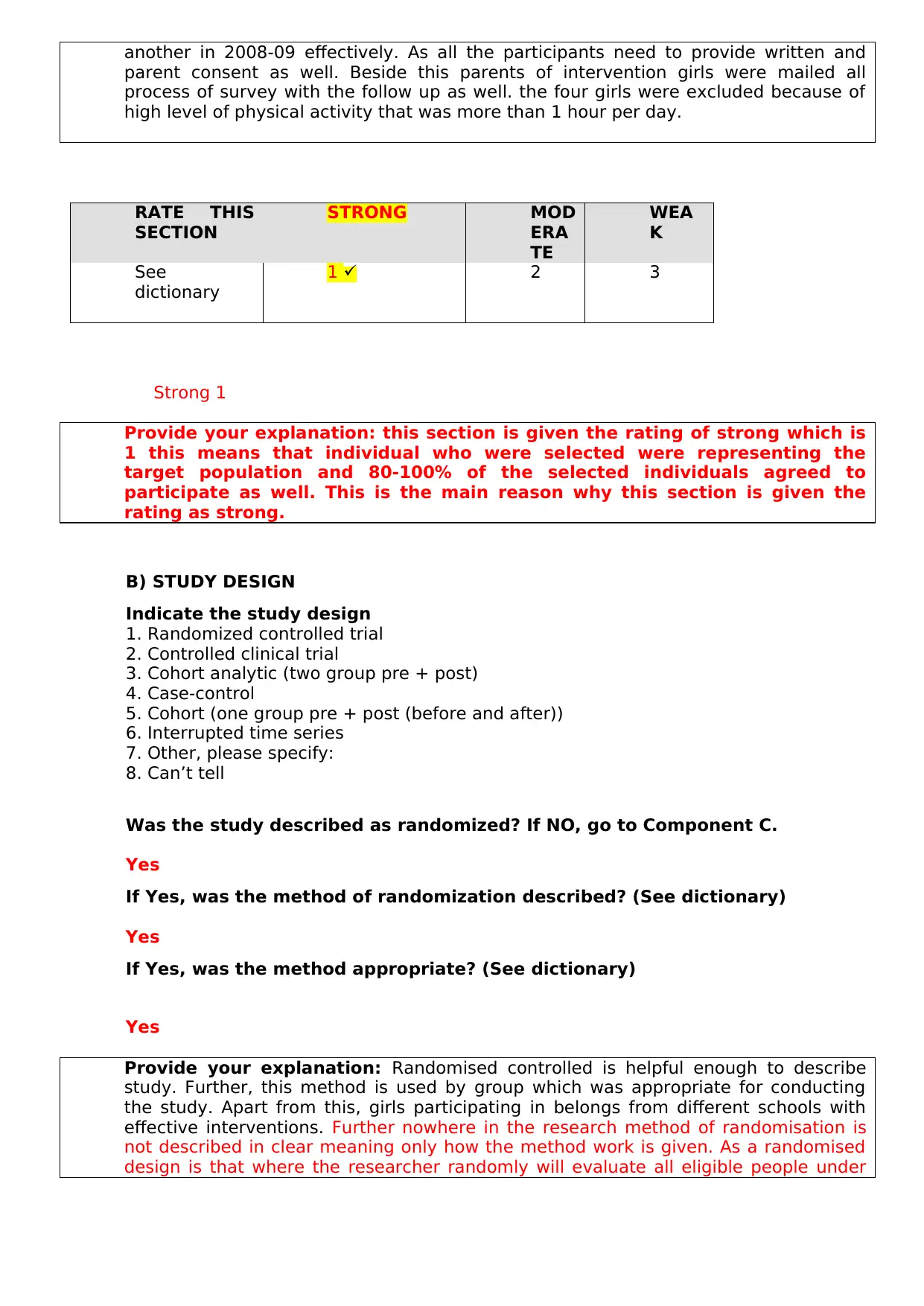
another in 2008-09 effectively. As all the participants need to provide written and
parent consent as well. Beside this parents of intervention girls were mailed all
process of survey with the follow up as well. the four girls were excluded because of
high level of physical activity that was more than 1 hour per day.
RATE THIS
SECTION
STRONG MOD
ERA
TE
WEA
K
See
dictionary
1 2 3
Strong 1
Provide your explanation: this section is given the rating of strong which is
1 this means that individual who were selected were representing the
target population and 80-100% of the selected individuals agreed to
participate as well. This is the main reason why this section is given the
rating as strong.
B) STUDY DESIGN
Indicate the study design
1. Randomized controlled trial
2. Controlled clinical trial
3. Cohort analytic (two group pre + post)
4. Case-control
5. Cohort (one group pre + post (before and after))
6. Interrupted time series
7. Other, please specify:
8. Can’t tell
Was the study described as randomized? If NO, go to Component C.
Yes
If Yes, was the method of randomization described? (See dictionary)
Yes
If Yes, was the method appropriate? (See dictionary)
Yes
Provide your explanation: Randomised controlled is helpful enough to describe
study. Further, this method is used by group which was appropriate for conducting
the study. Apart from this, girls participating in belongs from different schools with
effective interventions. Further nowhere in the research method of randomisation is
not described in clear meaning only how the method work is given. As a randomised
design is that where the researcher randomly will evaluate all eligible people under
parent consent as well. Beside this parents of intervention girls were mailed all
process of survey with the follow up as well. the four girls were excluded because of
high level of physical activity that was more than 1 hour per day.
RATE THIS
SECTION
STRONG MOD
ERA
TE
WEA
K
See
dictionary
1 2 3
Strong 1
Provide your explanation: this section is given the rating of strong which is
1 this means that individual who were selected were representing the
target population and 80-100% of the selected individuals agreed to
participate as well. This is the main reason why this section is given the
rating as strong.
B) STUDY DESIGN
Indicate the study design
1. Randomized controlled trial
2. Controlled clinical trial
3. Cohort analytic (two group pre + post)
4. Case-control
5. Cohort (one group pre + post (before and after))
6. Interrupted time series
7. Other, please specify:
8. Can’t tell
Was the study described as randomized? If NO, go to Component C.
Yes
If Yes, was the method of randomization described? (See dictionary)
Yes
If Yes, was the method appropriate? (See dictionary)
Yes
Provide your explanation: Randomised controlled is helpful enough to describe
study. Further, this method is used by group which was appropriate for conducting
the study. Apart from this, girls participating in belongs from different schools with
effective interventions. Further nowhere in the research method of randomisation is
not described in clear meaning only how the method work is given. As a randomised
design is that where the researcher randomly will evaluate all eligible people under
⊘ This is a preview!⊘
Do you want full access?
Subscribe today to unlock all pages.

Trusted by 1+ million students worldwide
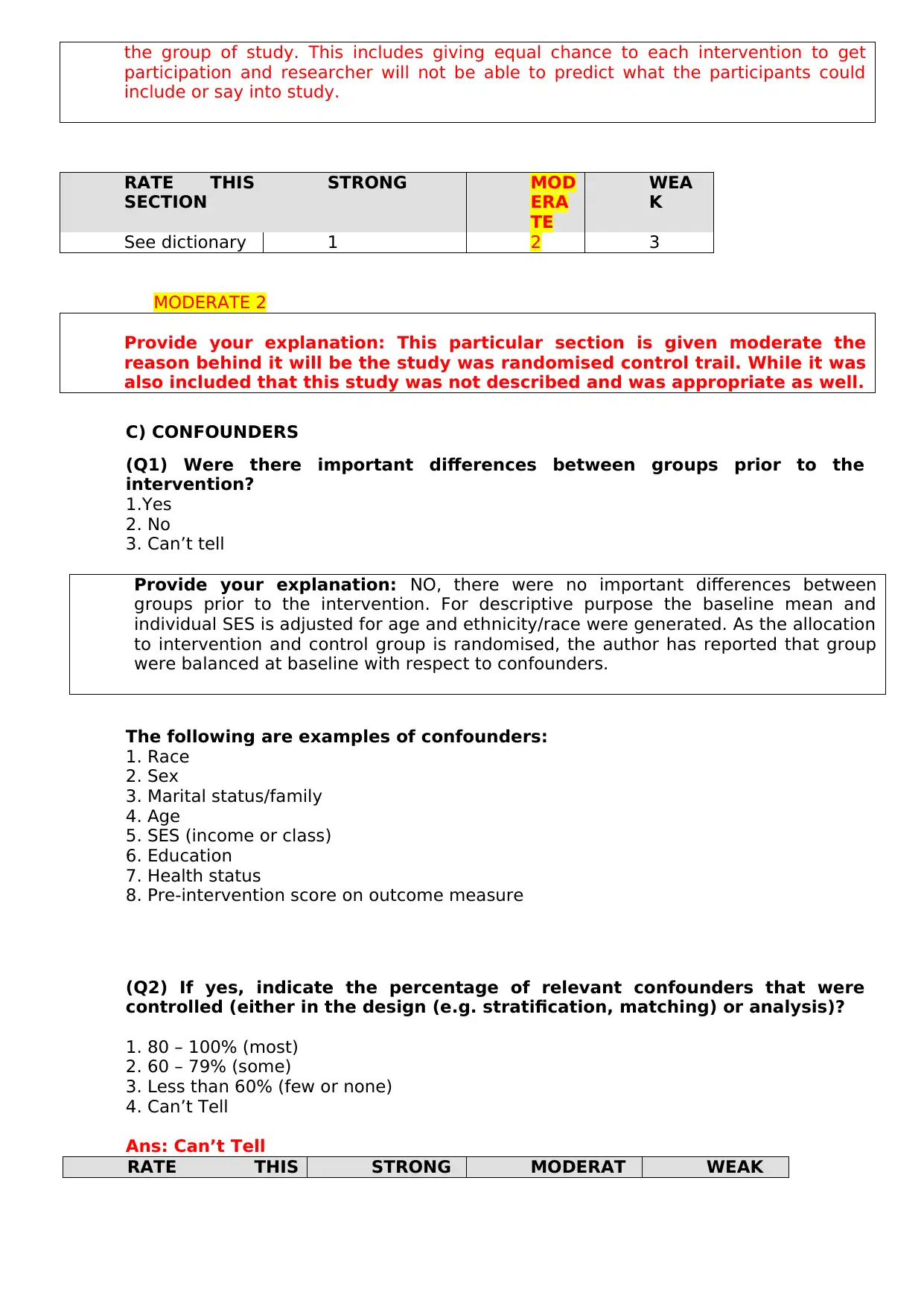
the group of study. This includes giving equal chance to each intervention to get
participation and researcher will not be able to predict what the participants could
include or say into study.
RATE THIS
SECTION
STRONG MOD
ERA
TE
WEA
K
See dictionary 1 2 3
MODERATE 2
Provide your explanation: This particular section is given moderate the
reason behind it will be the study was randomised control trail. While it was
also included that this study was not described and was appropriate as well.
C) CONFOUNDERS
(Q1) Were there important differences between groups prior to the
intervention?
1.Yes
2. No
3. Can’t tell
Provide your explanation: NO, there were no important differences between
groups prior to the intervention. For descriptive purpose the baseline mean and
individual SES is adjusted for age and ethnicity/race were generated. As the allocation
to intervention and control group is randomised, the author has reported that group
were balanced at baseline with respect to confounders.
The following are examples of confounders:
1. Race
2. Sex
3. Marital status/family
4. Age
5. SES (income or class)
6. Education
7. Health status
8. Pre-intervention score on outcome measure
(Q2) If yes, indicate the percentage of relevant confounders that were
controlled (either in the design (e.g. stratification, matching) or analysis)?
1. 80 – 100% (most)
2. 60 – 79% (some)
3. Less than 60% (few or none)
4. Can’t Tell
Ans: Can’t Tell
RATE THIS STRONG MODERAT WEAK
participation and researcher will not be able to predict what the participants could
include or say into study.
RATE THIS
SECTION
STRONG MOD
ERA
TE
WEA
K
See dictionary 1 2 3
MODERATE 2
Provide your explanation: This particular section is given moderate the
reason behind it will be the study was randomised control trail. While it was
also included that this study was not described and was appropriate as well.
C) CONFOUNDERS
(Q1) Were there important differences between groups prior to the
intervention?
1.Yes
2. No
3. Can’t tell
Provide your explanation: NO, there were no important differences between
groups prior to the intervention. For descriptive purpose the baseline mean and
individual SES is adjusted for age and ethnicity/race were generated. As the allocation
to intervention and control group is randomised, the author has reported that group
were balanced at baseline with respect to confounders.
The following are examples of confounders:
1. Race
2. Sex
3. Marital status/family
4. Age
5. SES (income or class)
6. Education
7. Health status
8. Pre-intervention score on outcome measure
(Q2) If yes, indicate the percentage of relevant confounders that were
controlled (either in the design (e.g. stratification, matching) or analysis)?
1. 80 – 100% (most)
2. 60 – 79% (some)
3. Less than 60% (few or none)
4. Can’t Tell
Ans: Can’t Tell
RATE THIS STRONG MODERAT WEAK
Paraphrase This Document
Need a fresh take? Get an instant paraphrase of this document with our AI Paraphraser
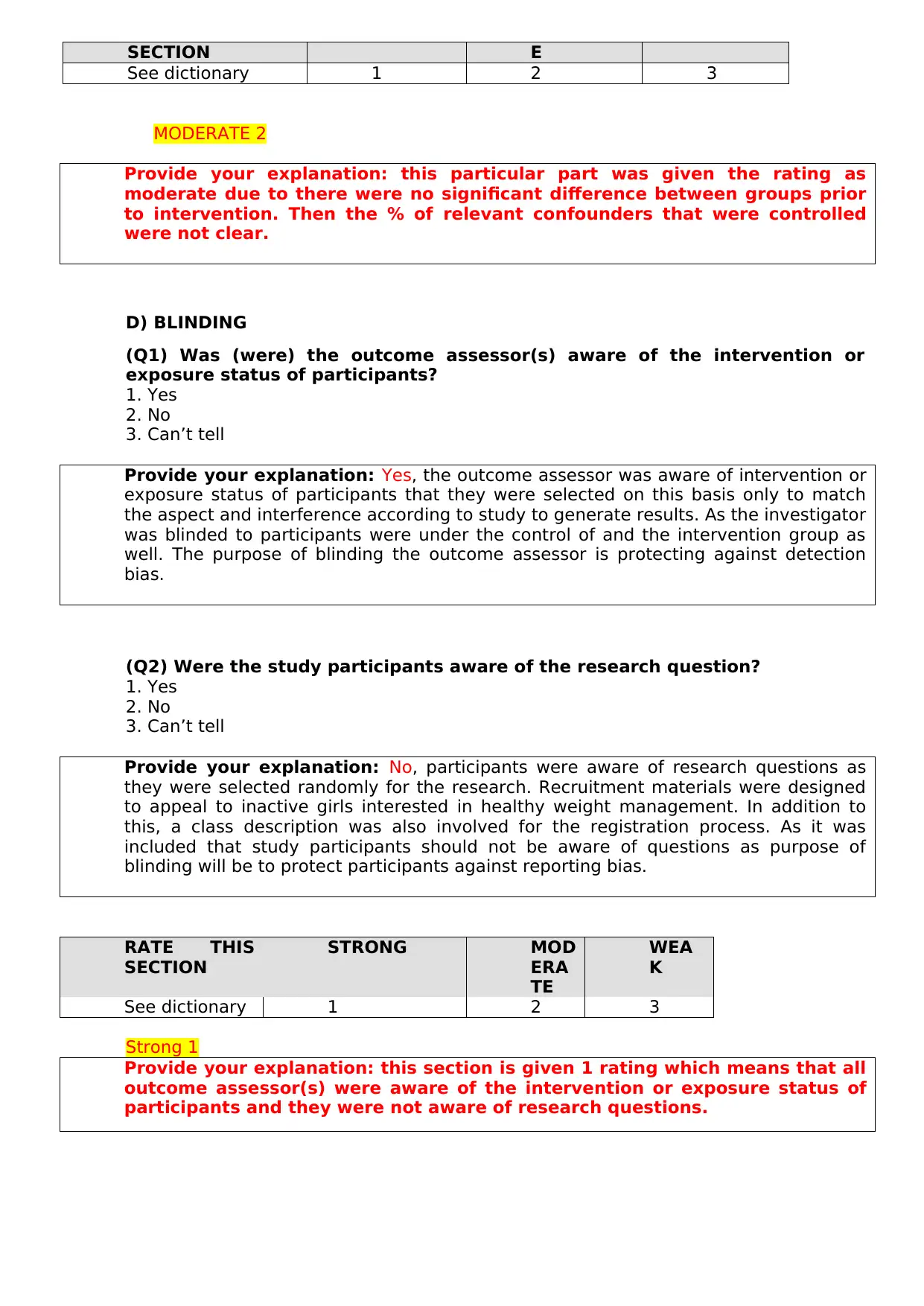
SECTION E
See dictionary 1 2 3
MODERATE 2
Provide your explanation: this particular part was given the rating as
moderate due to there were no significant difference between groups prior
to intervention. Then the % of relevant confounders that were controlled
were not clear.
D) BLINDING
(Q1) Was (were) the outcome assessor(s) aware of the intervention or
exposure status of participants?
1. Yes
2. No
3. Can’t tell
Provide your explanation: Yes, the outcome assessor was aware of intervention or
exposure status of participants that they were selected on this basis only to match
the aspect and interference according to study to generate results. As the investigator
was blinded to participants were under the control of and the intervention group as
well. The purpose of blinding the outcome assessor is protecting against detection
bias.
(Q2) Were the study participants aware of the research question?
1. Yes
2. No
3. Can’t tell
Provide your explanation: No, participants were aware of research questions as
they were selected randomly for the research. Recruitment materials were designed
to appeal to inactive girls interested in healthy weight management. In addition to
this, a class description was also involved for the registration process. As it was
included that study participants should not be aware of questions as purpose of
blinding will be to protect participants against reporting bias.
RATE THIS
SECTION
STRONG MOD
ERA
TE
WEA
K
See dictionary 1 2 3
Strong 1
Provide your explanation: this section is given 1 rating which means that all
outcome assessor(s) were aware of the intervention or exposure status of
participants and they were not aware of research questions.
See dictionary 1 2 3
MODERATE 2
Provide your explanation: this particular part was given the rating as
moderate due to there were no significant difference between groups prior
to intervention. Then the % of relevant confounders that were controlled
were not clear.
D) BLINDING
(Q1) Was (were) the outcome assessor(s) aware of the intervention or
exposure status of participants?
1. Yes
2. No
3. Can’t tell
Provide your explanation: Yes, the outcome assessor was aware of intervention or
exposure status of participants that they were selected on this basis only to match
the aspect and interference according to study to generate results. As the investigator
was blinded to participants were under the control of and the intervention group as
well. The purpose of blinding the outcome assessor is protecting against detection
bias.
(Q2) Were the study participants aware of the research question?
1. Yes
2. No
3. Can’t tell
Provide your explanation: No, participants were aware of research questions as
they were selected randomly for the research. Recruitment materials were designed
to appeal to inactive girls interested in healthy weight management. In addition to
this, a class description was also involved for the registration process. As it was
included that study participants should not be aware of questions as purpose of
blinding will be to protect participants against reporting bias.
RATE THIS
SECTION
STRONG MOD
ERA
TE
WEA
K
See dictionary 1 2 3
Strong 1
Provide your explanation: this section is given 1 rating which means that all
outcome assessor(s) were aware of the intervention or exposure status of
participants and they were not aware of research questions.
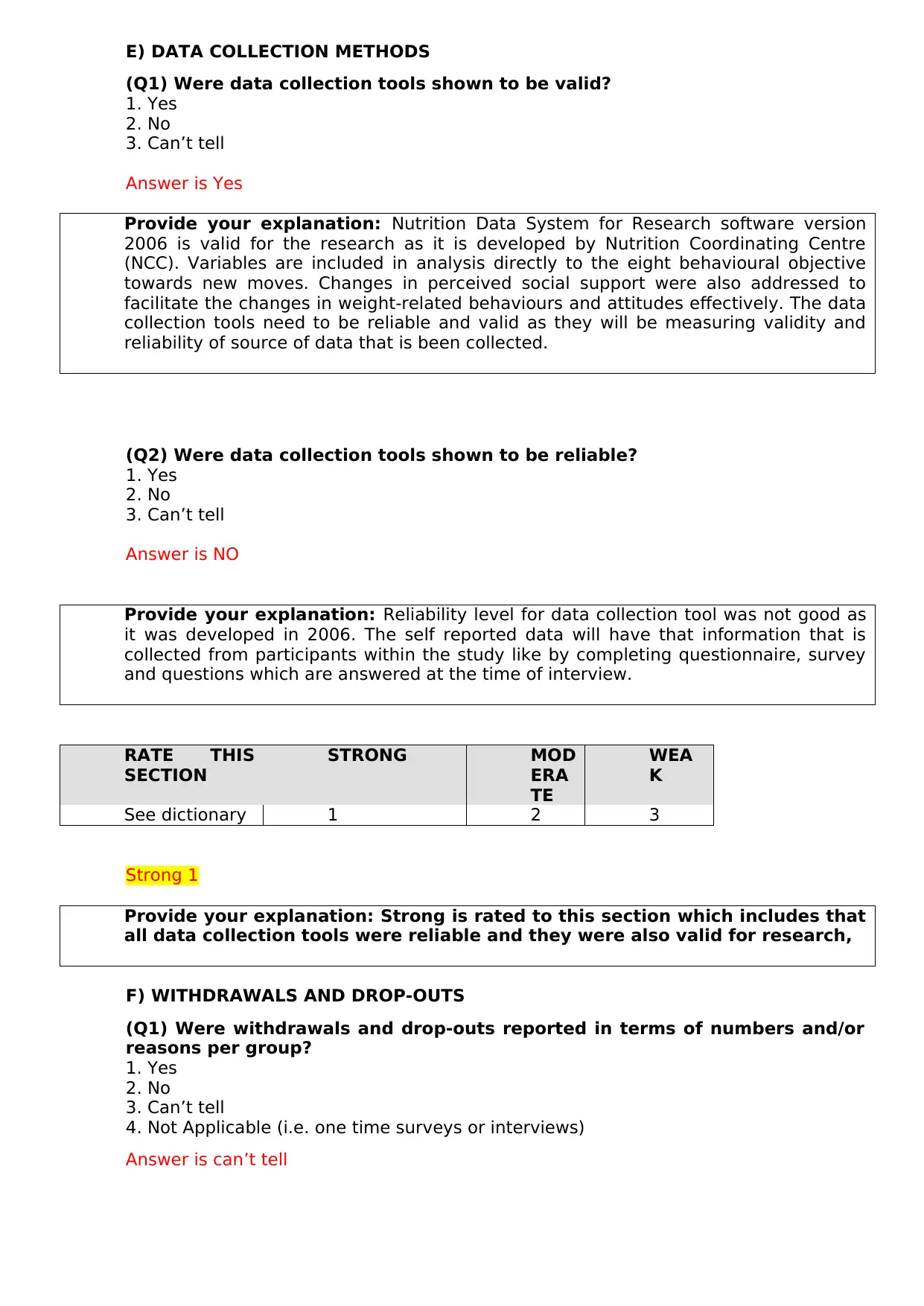
E) DATA COLLECTION METHODS
(Q1) Were data collection tools shown to be valid?
1. Yes
2. No
3. Can’t tell
Answer is Yes
Provide your explanation: Nutrition Data System for Research software version
2006 is valid for the research as it is developed by Nutrition Coordinating Centre
(NCC). Variables are included in analysis directly to the eight behavioural objective
towards new moves. Changes in perceived social support were also addressed to
facilitate the changes in weight-related behaviours and attitudes effectively. The data
collection tools need to be reliable and valid as they will be measuring validity and
reliability of source of data that is been collected.
(Q2) Were data collection tools shown to be reliable?
1. Yes
2. No
3. Can’t tell
Answer is NO
Provide your explanation: Reliability level for data collection tool was not good as
it was developed in 2006. The self reported data will have that information that is
collected from participants within the study like by completing questionnaire, survey
and questions which are answered at the time of interview.
RATE THIS
SECTION
STRONG MOD
ERA
TE
WEA
K
See dictionary 1 2 3
Strong 1
Provide your explanation: Strong is rated to this section which includes that
all data collection tools were reliable and they were also valid for research,
F) WITHDRAWALS AND DROP-OUTS
(Q1) Were withdrawals and drop-outs reported in terms of numbers and/or
reasons per group?
1. Yes
2. No
3. Can’t tell
4. Not Applicable (i.e. one time surveys or interviews)
Answer is can’t tell
(Q1) Were data collection tools shown to be valid?
1. Yes
2. No
3. Can’t tell
Answer is Yes
Provide your explanation: Nutrition Data System for Research software version
2006 is valid for the research as it is developed by Nutrition Coordinating Centre
(NCC). Variables are included in analysis directly to the eight behavioural objective
towards new moves. Changes in perceived social support were also addressed to
facilitate the changes in weight-related behaviours and attitudes effectively. The data
collection tools need to be reliable and valid as they will be measuring validity and
reliability of source of data that is been collected.
(Q2) Were data collection tools shown to be reliable?
1. Yes
2. No
3. Can’t tell
Answer is NO
Provide your explanation: Reliability level for data collection tool was not good as
it was developed in 2006. The self reported data will have that information that is
collected from participants within the study like by completing questionnaire, survey
and questions which are answered at the time of interview.
RATE THIS
SECTION
STRONG MOD
ERA
TE
WEA
K
See dictionary 1 2 3
Strong 1
Provide your explanation: Strong is rated to this section which includes that
all data collection tools were reliable and they were also valid for research,
F) WITHDRAWALS AND DROP-OUTS
(Q1) Were withdrawals and drop-outs reported in terms of numbers and/or
reasons per group?
1. Yes
2. No
3. Can’t tell
4. Not Applicable (i.e. one time surveys or interviews)
Answer is can’t tell
⊘ This is a preview!⊘
Do you want full access?
Subscribe today to unlock all pages.

Trusted by 1+ million students worldwide
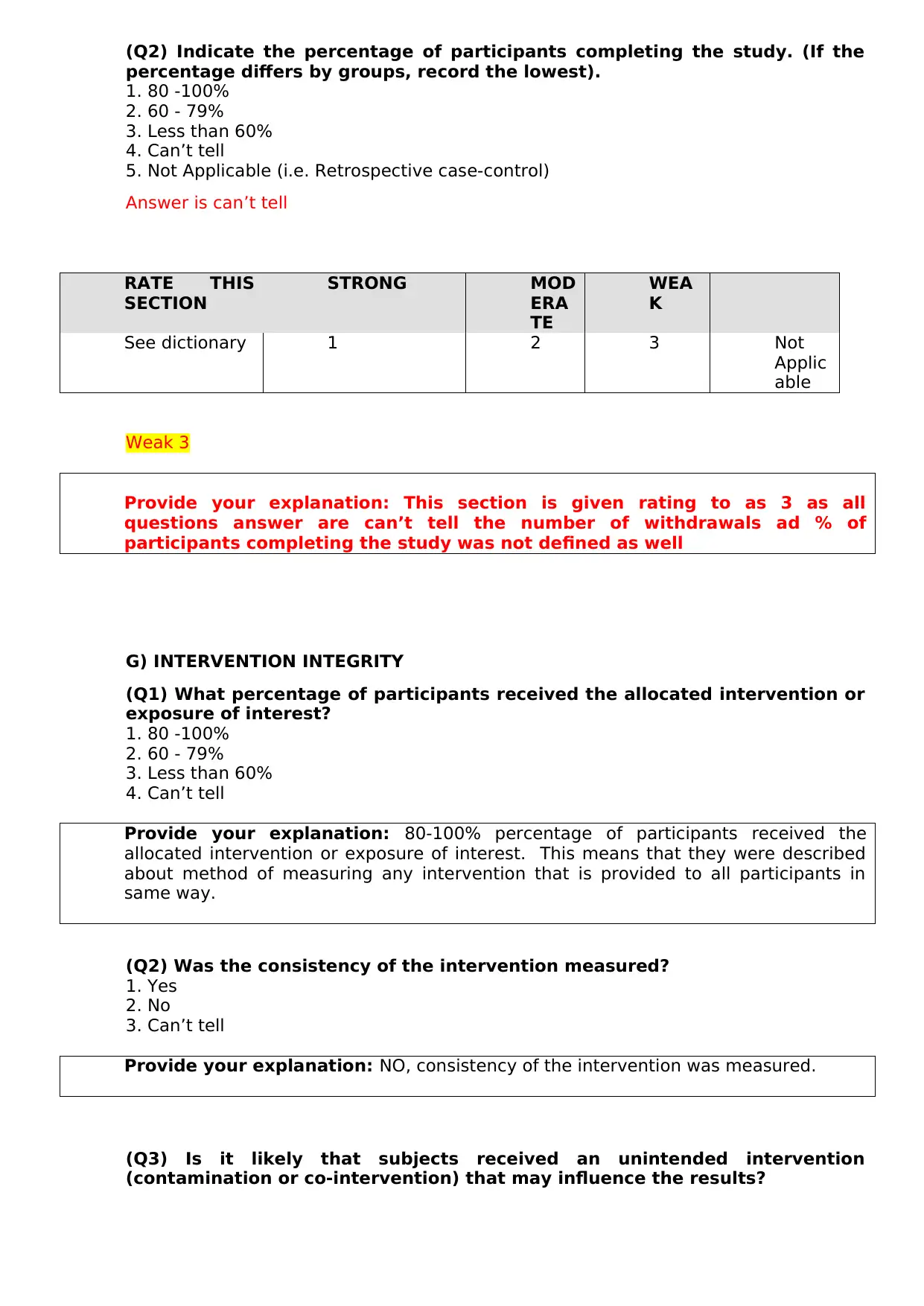
(Q2) Indicate the percentage of participants completing the study. (If the
percentage differs by groups, record the lowest).
1. 80 -100%
2. 60 - 79%
3. Less than 60%
4. Can’t tell
5. Not Applicable (i.e. Retrospective case-control)
Answer is can’t tell
RATE THIS
SECTION
STRONG MOD
ERA
TE
WEA
K
See dictionary 1 2 3 Not
Applic
able
Weak 3
Provide your explanation: This section is given rating to as 3 as all
questions answer are can’t tell the number of withdrawals ad % of
participants completing the study was not defined as well
G) INTERVENTION INTEGRITY
(Q1) What percentage of participants received the allocated intervention or
exposure of interest?
1. 80 -100%
2. 60 - 79%
3. Less than 60%
4. Can’t tell
Provide your explanation: 80-100% percentage of participants received the
allocated intervention or exposure of interest. This means that they were described
about method of measuring any intervention that is provided to all participants in
same way.
(Q2) Was the consistency of the intervention measured?
1. Yes
2. No
3. Can’t tell
Provide your explanation: NO, consistency of the intervention was measured.
(Q3) Is it likely that subjects received an unintended intervention
(contamination or co-intervention) that may influence the results?
percentage differs by groups, record the lowest).
1. 80 -100%
2. 60 - 79%
3. Less than 60%
4. Can’t tell
5. Not Applicable (i.e. Retrospective case-control)
Answer is can’t tell
RATE THIS
SECTION
STRONG MOD
ERA
TE
WEA
K
See dictionary 1 2 3 Not
Applic
able
Weak 3
Provide your explanation: This section is given rating to as 3 as all
questions answer are can’t tell the number of withdrawals ad % of
participants completing the study was not defined as well
G) INTERVENTION INTEGRITY
(Q1) What percentage of participants received the allocated intervention or
exposure of interest?
1. 80 -100%
2. 60 - 79%
3. Less than 60%
4. Can’t tell
Provide your explanation: 80-100% percentage of participants received the
allocated intervention or exposure of interest. This means that they were described
about method of measuring any intervention that is provided to all participants in
same way.
(Q2) Was the consistency of the intervention measured?
1. Yes
2. No
3. Can’t tell
Provide your explanation: NO, consistency of the intervention was measured.
(Q3) Is it likely that subjects received an unintended intervention
(contamination or co-intervention) that may influence the results?
Paraphrase This Document
Need a fresh take? Get an instant paraphrase of this document with our AI Paraphraser
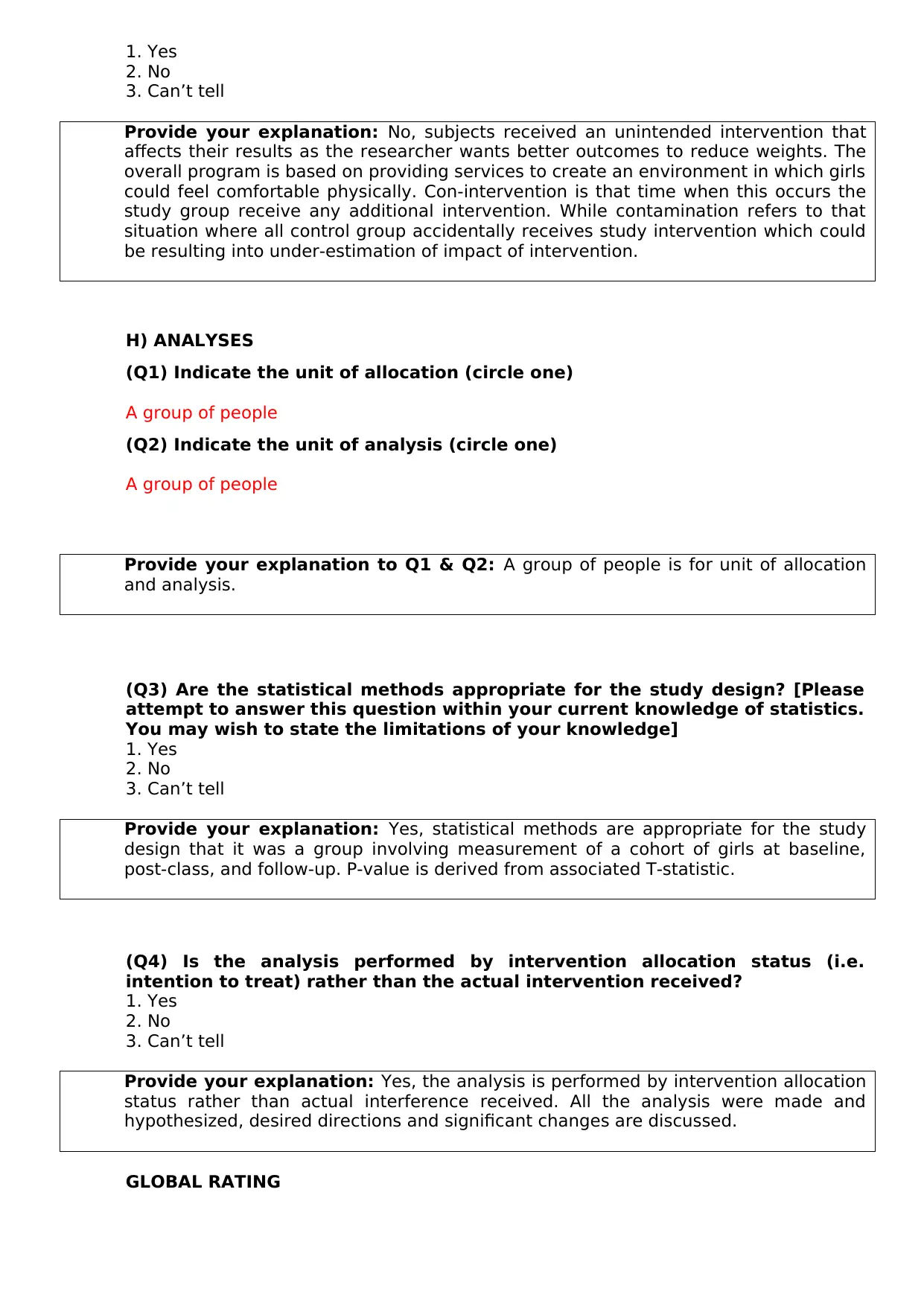
1. Yes
2. No
3. Can’t tell
Provide your explanation: No, subjects received an unintended intervention that
affects their results as the researcher wants better outcomes to reduce weights. The
overall program is based on providing services to create an environment in which girls
could feel comfortable physically. Con-intervention is that time when this occurs the
study group receive any additional intervention. While contamination refers to that
situation where all control group accidentally receives study intervention which could
be resulting into under-estimation of impact of intervention.
H) ANALYSES
(Q1) Indicate the unit of allocation (circle one)
A group of people
(Q2) Indicate the unit of analysis (circle one)
A group of people
Provide your explanation to Q1 & Q2: A group of people is for unit of allocation
and analysis.
(Q3) Are the statistical methods appropriate for the study design? [Please
attempt to answer this question within your current knowledge of statistics.
You may wish to state the limitations of your knowledge]
1. Yes
2. No
3. Can’t tell
Provide your explanation: Yes, statistical methods are appropriate for the study
design that it was a group involving measurement of a cohort of girls at baseline,
post-class, and follow-up. P-value is derived from associated T-statistic.
(Q4) Is the analysis performed by intervention allocation status (i.e.
intention to treat) rather than the actual intervention received?
1. Yes
2. No
3. Can’t tell
Provide your explanation: Yes, the analysis is performed by intervention allocation
status rather than actual interference received. All the analysis were made and
hypothesized, desired directions and significant changes are discussed.
GLOBAL RATING
2. No
3. Can’t tell
Provide your explanation: No, subjects received an unintended intervention that
affects their results as the researcher wants better outcomes to reduce weights. The
overall program is based on providing services to create an environment in which girls
could feel comfortable physically. Con-intervention is that time when this occurs the
study group receive any additional intervention. While contamination refers to that
situation where all control group accidentally receives study intervention which could
be resulting into under-estimation of impact of intervention.
H) ANALYSES
(Q1) Indicate the unit of allocation (circle one)
A group of people
(Q2) Indicate the unit of analysis (circle one)
A group of people
Provide your explanation to Q1 & Q2: A group of people is for unit of allocation
and analysis.
(Q3) Are the statistical methods appropriate for the study design? [Please
attempt to answer this question within your current knowledge of statistics.
You may wish to state the limitations of your knowledge]
1. Yes
2. No
3. Can’t tell
Provide your explanation: Yes, statistical methods are appropriate for the study
design that it was a group involving measurement of a cohort of girls at baseline,
post-class, and follow-up. P-value is derived from associated T-statistic.
(Q4) Is the analysis performed by intervention allocation status (i.e.
intention to treat) rather than the actual intervention received?
1. Yes
2. No
3. Can’t tell
Provide your explanation: Yes, the analysis is performed by intervention allocation
status rather than actual interference received. All the analysis were made and
hypothesized, desired directions and significant changes are discussed.
GLOBAL RATING

COMPONENT RATINGS
Please transcribe the information from the grey boxes on pages 1-4 onto this page.
See dictionary on how to rate this section.
SELECTION BIAS ST
RO
NG
MODE
RATE
WEAK
Provide your
explanation: 1
(Strong), as all the
participants agreed to
participate in study and
also they were likely to
take part of research.
1 2 3
STUDY DESIGN ST
RO
NG
MODE
RATE
WEAK
Provide your
explanation: 1
(Strong), as Randomised
controlled trial design is
used along with group.
This method enables to
analyse the impact of
school-based
intervention aimed at
preventing weight-
related problems in
adolescent girls.
1 2 3
CONFOUNDERS ST
RO
NG
MODE
RATE
WEAK
Provide your
explanation: 2
(Moderate), as the
ethnicity and race were
generated for
descriptive purpose.
1 2 3
BLINDING ST
RO
NG
MODE
RATE
WEAK
Provide your
explanation: 2
(Moderate), as
researcher was aware of
exposure and
intervention of
participants but not of
research questions.
1 2 3
DATA COLLECTION
METHOD
ST
RO
NG
MODE
RATE
WEAK
Provide your
explanation: 3 (Weak),
this section is weak that
data collection tool used
1 2 3
Please transcribe the information from the grey boxes on pages 1-4 onto this page.
See dictionary on how to rate this section.
SELECTION BIAS ST
RO
NG
MODE
RATE
WEAK
Provide your
explanation: 1
(Strong), as all the
participants agreed to
participate in study and
also they were likely to
take part of research.
1 2 3
STUDY DESIGN ST
RO
NG
MODE
RATE
WEAK
Provide your
explanation: 1
(Strong), as Randomised
controlled trial design is
used along with group.
This method enables to
analyse the impact of
school-based
intervention aimed at
preventing weight-
related problems in
adolescent girls.
1 2 3
CONFOUNDERS ST
RO
NG
MODE
RATE
WEAK
Provide your
explanation: 2
(Moderate), as the
ethnicity and race were
generated for
descriptive purpose.
1 2 3
BLINDING ST
RO
NG
MODE
RATE
WEAK
Provide your
explanation: 2
(Moderate), as
researcher was aware of
exposure and
intervention of
participants but not of
research questions.
1 2 3
DATA COLLECTION
METHOD
ST
RO
NG
MODE
RATE
WEAK
Provide your
explanation: 3 (Weak),
this section is weak that
data collection tool used
1 2 3
⊘ This is a preview!⊘
Do you want full access?
Subscribe today to unlock all pages.

Trusted by 1+ million students worldwide
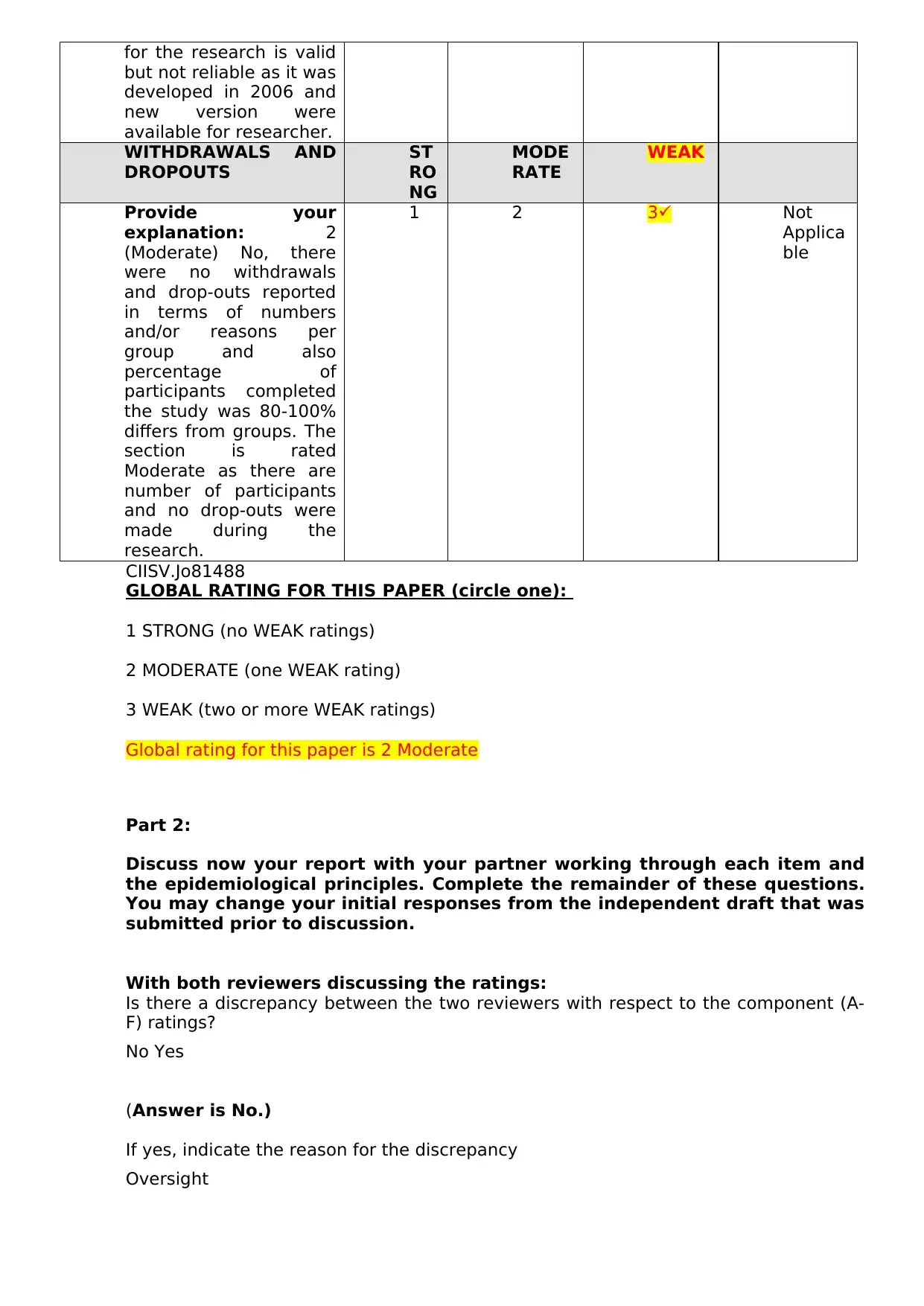
for the research is valid
but not reliable as it was
developed in 2006 and
new version were
available for researcher.
WITHDRAWALS AND
DROPOUTS
ST
RO
NG
MODE
RATE
WEAK
Provide your
explanation: 2
(Moderate) No, there
were no withdrawals
and drop-outs reported
in terms of numbers
and/or reasons per
group and also
percentage of
participants completed
the study was 80-100%
differs from groups. The
section is rated
Moderate as there are
number of participants
and no drop-outs were
made during the
research.
1 2 3 Not
Applica
ble
CIISV.Jo81488
GLOBAL RATING FOR THIS PAPER (circle one):
1 STRONG (no WEAK ratings)
2 MODERATE (one WEAK rating)
3 WEAK (two or more WEAK ratings)
Global rating for this paper is 2 Moderate
Part 2:
Discuss now your report with your partner working through each item and
the epidemiological principles. Complete the remainder of these questions.
You may change your initial responses from the independent draft that was
submitted prior to discussion.
With both reviewers discussing the ratings:
Is there a discrepancy between the two reviewers with respect to the component (A-
F) ratings?
No Yes
(Answer is No.)
If yes, indicate the reason for the discrepancy
Oversight
but not reliable as it was
developed in 2006 and
new version were
available for researcher.
WITHDRAWALS AND
DROPOUTS
ST
RO
NG
MODE
RATE
WEAK
Provide your
explanation: 2
(Moderate) No, there
were no withdrawals
and drop-outs reported
in terms of numbers
and/or reasons per
group and also
percentage of
participants completed
the study was 80-100%
differs from groups. The
section is rated
Moderate as there are
number of participants
and no drop-outs were
made during the
research.
1 2 3 Not
Applica
ble
CIISV.Jo81488
GLOBAL RATING FOR THIS PAPER (circle one):
1 STRONG (no WEAK ratings)
2 MODERATE (one WEAK rating)
3 WEAK (two or more WEAK ratings)
Global rating for this paper is 2 Moderate
Part 2:
Discuss now your report with your partner working through each item and
the epidemiological principles. Complete the remainder of these questions.
You may change your initial responses from the independent draft that was
submitted prior to discussion.
With both reviewers discussing the ratings:
Is there a discrepancy between the two reviewers with respect to the component (A-
F) ratings?
No Yes
(Answer is No.)
If yes, indicate the reason for the discrepancy
Oversight
Paraphrase This Document
Need a fresh take? Get an instant paraphrase of this document with our AI Paraphraser
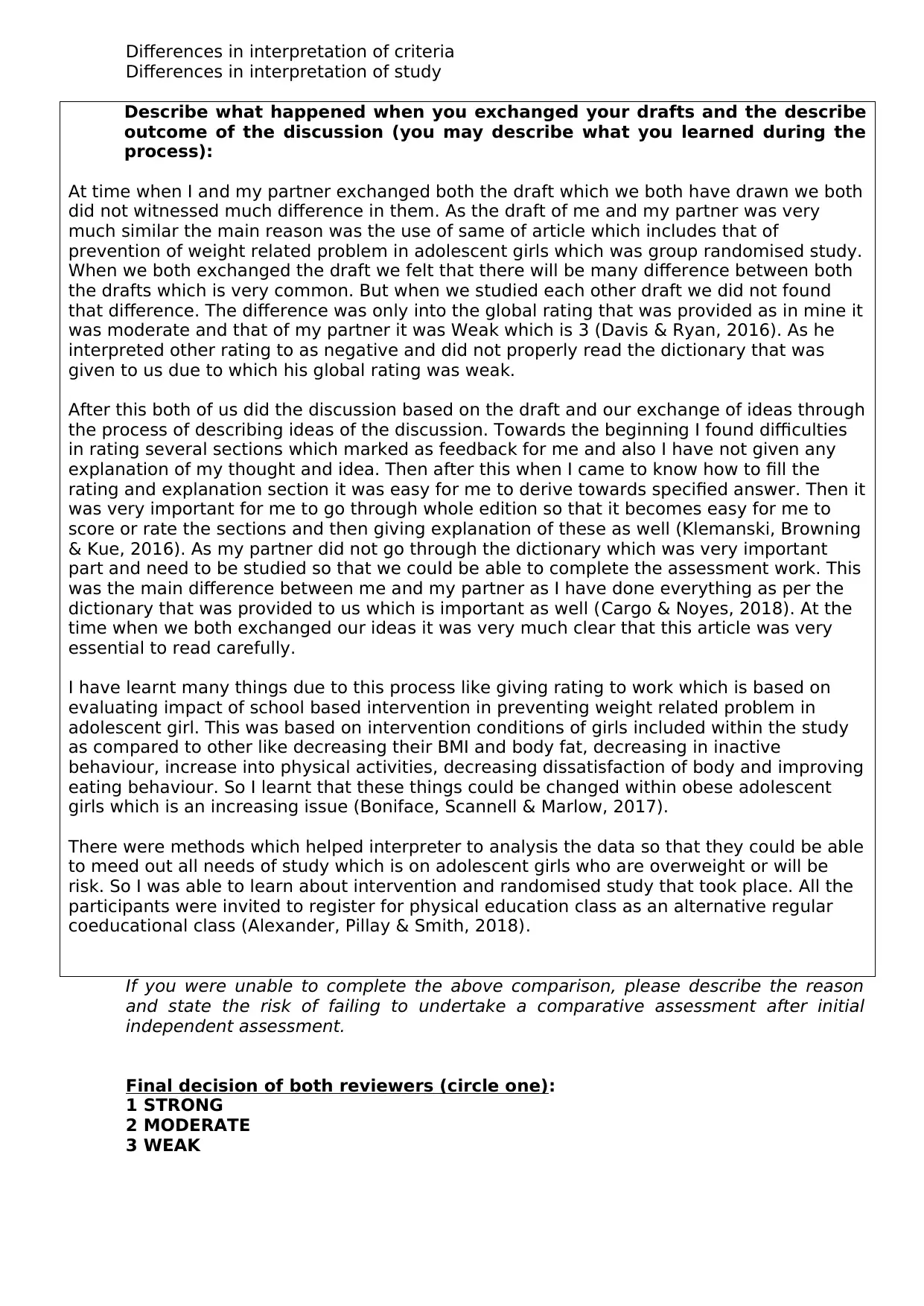
Differences in interpretation of criteria
Differences in interpretation of study
Describe what happened when you exchanged your drafts and the describe
outcome of the discussion (you may describe what you learned during the
process):
At time when I and my partner exchanged both the draft which we both have drawn we both
did not witnessed much difference in them. As the draft of me and my partner was very
much similar the main reason was the use of same of article which includes that of
prevention of weight related problem in adolescent girls which was group randomised study.
When we both exchanged the draft we felt that there will be many difference between both
the drafts which is very common. But when we studied each other draft we did not found
that difference. The difference was only into the global rating that was provided as in mine it
was moderate and that of my partner it was Weak which is 3 (Davis & Ryan, 2016). As he
interpreted other rating to as negative and did not properly read the dictionary that was
given to us due to which his global rating was weak.
After this both of us did the discussion based on the draft and our exchange of ideas through
the process of describing ideas of the discussion. Towards the beginning I found difficulties
in rating several sections which marked as feedback for me and also I have not given any
explanation of my thought and idea. Then after this when I came to know how to fill the
rating and explanation section it was easy for me to derive towards specified answer. Then it
was very important for me to go through whole edition so that it becomes easy for me to
score or rate the sections and then giving explanation of these as well (Klemanski, Browning
& Kue, 2016). As my partner did not go through the dictionary which was very important
part and need to be studied so that we could be able to complete the assessment work. This
was the main difference between me and my partner as I have done everything as per the
dictionary that was provided to us which is important as well (Cargo & Noyes, 2018). At the
time when we both exchanged our ideas it was very much clear that this article was very
essential to read carefully.
I have learnt many things due to this process like giving rating to work which is based on
evaluating impact of school based intervention in preventing weight related problem in
adolescent girl. This was based on intervention conditions of girls included within the study
as compared to other like decreasing their BMI and body fat, decreasing in inactive
behaviour, increase into physical activities, decreasing dissatisfaction of body and improving
eating behaviour. So I learnt that these things could be changed within obese adolescent
girls which is an increasing issue (Boniface, Scannell & Marlow, 2017).
There were methods which helped interpreter to analysis the data so that they could be able
to meed out all needs of study which is on adolescent girls who are overweight or will be
risk. So I was able to learn about intervention and randomised study that took place. All the
participants were invited to register for physical education class as an alternative regular
coeducational class (Alexander, Pillay & Smith, 2018).
If you were unable to complete the above comparison, please describe the reason
and state the risk of failing to undertake a comparative assessment after initial
independent assessment.
Final decision of both reviewers (circle one):
1 STRONG
2 MODERATE
3 WEAK
Differences in interpretation of study
Describe what happened when you exchanged your drafts and the describe
outcome of the discussion (you may describe what you learned during the
process):
At time when I and my partner exchanged both the draft which we both have drawn we both
did not witnessed much difference in them. As the draft of me and my partner was very
much similar the main reason was the use of same of article which includes that of
prevention of weight related problem in adolescent girls which was group randomised study.
When we both exchanged the draft we felt that there will be many difference between both
the drafts which is very common. But when we studied each other draft we did not found
that difference. The difference was only into the global rating that was provided as in mine it
was moderate and that of my partner it was Weak which is 3 (Davis & Ryan, 2016). As he
interpreted other rating to as negative and did not properly read the dictionary that was
given to us due to which his global rating was weak.
After this both of us did the discussion based on the draft and our exchange of ideas through
the process of describing ideas of the discussion. Towards the beginning I found difficulties
in rating several sections which marked as feedback for me and also I have not given any
explanation of my thought and idea. Then after this when I came to know how to fill the
rating and explanation section it was easy for me to derive towards specified answer. Then it
was very important for me to go through whole edition so that it becomes easy for me to
score or rate the sections and then giving explanation of these as well (Klemanski, Browning
& Kue, 2016). As my partner did not go through the dictionary which was very important
part and need to be studied so that we could be able to complete the assessment work. This
was the main difference between me and my partner as I have done everything as per the
dictionary that was provided to us which is important as well (Cargo & Noyes, 2018). At the
time when we both exchanged our ideas it was very much clear that this article was very
essential to read carefully.
I have learnt many things due to this process like giving rating to work which is based on
evaluating impact of school based intervention in preventing weight related problem in
adolescent girl. This was based on intervention conditions of girls included within the study
as compared to other like decreasing their BMI and body fat, decreasing in inactive
behaviour, increase into physical activities, decreasing dissatisfaction of body and improving
eating behaviour. So I learnt that these things could be changed within obese adolescent
girls which is an increasing issue (Boniface, Scannell & Marlow, 2017).
There were methods which helped interpreter to analysis the data so that they could be able
to meed out all needs of study which is on adolescent girls who are overweight or will be
risk. So I was able to learn about intervention and randomised study that took place. All the
participants were invited to register for physical education class as an alternative regular
coeducational class (Alexander, Pillay & Smith, 2018).
If you were unable to complete the above comparison, please describe the reason
and state the risk of failing to undertake a comparative assessment after initial
independent assessment.
Final decision of both reviewers (circle one):
1 STRONG
2 MODERATE
3 WEAK
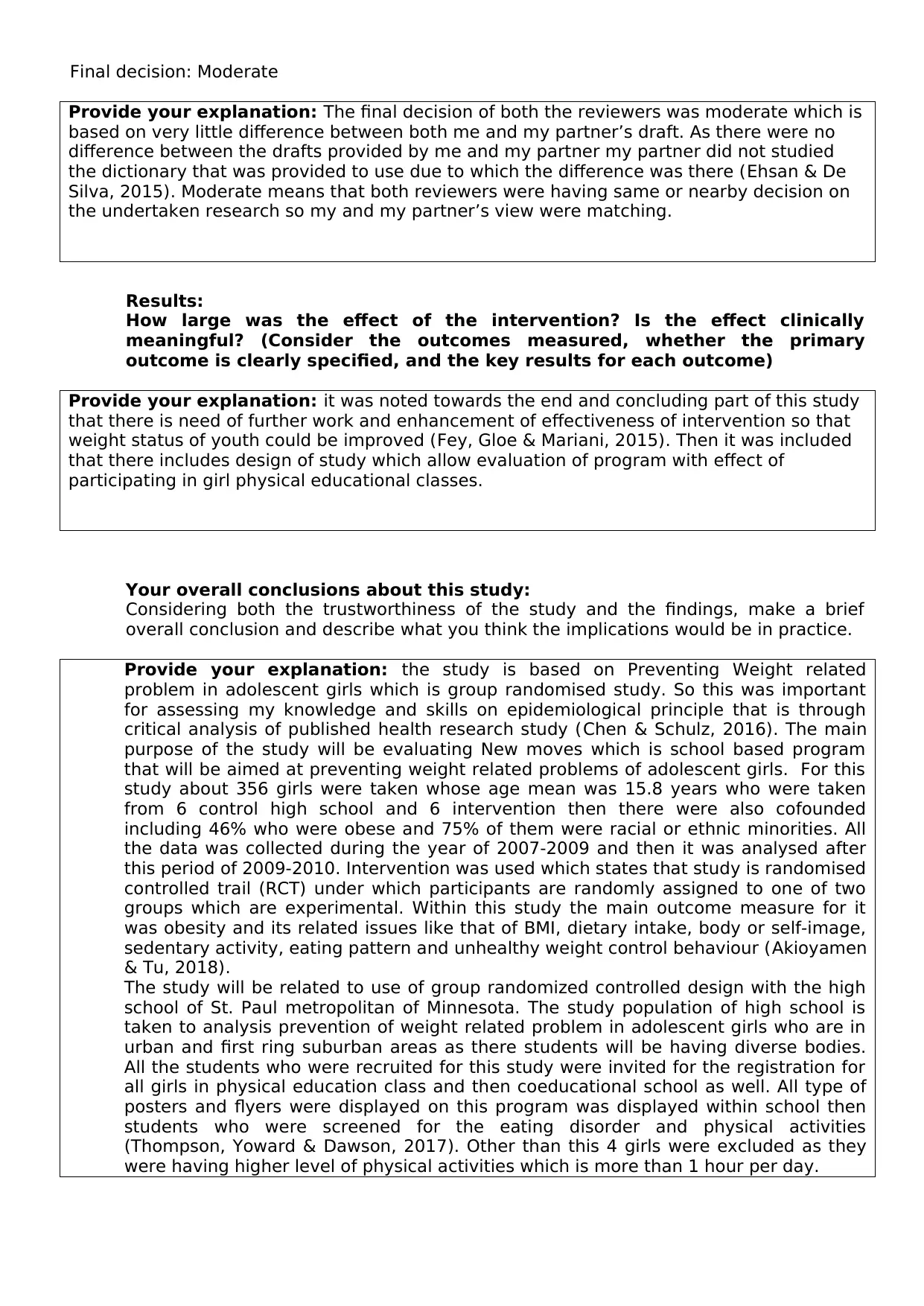
Final decision: Moderate
Provide your explanation: The final decision of both the reviewers was moderate which is
based on very little difference between both me and my partner’s draft. As there were no
difference between the drafts provided by me and my partner my partner did not studied
the dictionary that was provided to use due to which the difference was there (Ehsan & De
Silva, 2015). Moderate means that both reviewers were having same or nearby decision on
the undertaken research so my and my partner’s view were matching.
Results:
How large was the effect of the intervention? Is the effect clinically
meaningful? (Consider the outcomes measured, whether the primary
outcome is clearly specified, and the key results for each outcome)
Provide your explanation: it was noted towards the end and concluding part of this study
that there is need of further work and enhancement of effectiveness of intervention so that
weight status of youth could be improved (Fey, Gloe & Mariani, 2015). Then it was included
that there includes design of study which allow evaluation of program with effect of
participating in girl physical educational classes.
Your overall conclusions about this study:
Considering both the trustworthiness of the study and the findings, make a brief
overall conclusion and describe what you think the implications would be in practice.
Provide your explanation: the study is based on Preventing Weight related
problem in adolescent girls which is group randomised study. So this was important
for assessing my knowledge and skills on epidemiological principle that is through
critical analysis of published health research study (Chen & Schulz, 2016). The main
purpose of the study will be evaluating New moves which is school based program
that will be aimed at preventing weight related problems of adolescent girls. For this
study about 356 girls were taken whose age mean was 15.8 years who were taken
from 6 control high school and 6 intervention then there were also cofounded
including 46% who were obese and 75% of them were racial or ethnic minorities. All
the data was collected during the year of 2007-2009 and then it was analysed after
this period of 2009-2010. Intervention was used which states that study is randomised
controlled trail (RCT) under which participants are randomly assigned to one of two
groups which are experimental. Within this study the main outcome measure for it
was obesity and its related issues like that of BMI, dietary intake, body or self-image,
sedentary activity, eating pattern and unhealthy weight control behaviour (Akioyamen
& Tu, 2018).
The study will be related to use of group randomized controlled design with the high
school of St. Paul metropolitan of Minnesota. The study population of high school is
taken to analysis prevention of weight related problem in adolescent girls who are in
urban and first ring suburban areas as there students will be having diverse bodies.
All the students who were recruited for this study were invited for the registration for
all girls in physical education class and then coeducational school as well. All type of
posters and flyers were displayed on this program was displayed within school then
students who were screened for the eating disorder and physical activities
(Thompson, Yoward & Dawson, 2017). Other than this 4 girls were excluded as they
were having higher level of physical activities which is more than 1 hour per day.
Provide your explanation: The final decision of both the reviewers was moderate which is
based on very little difference between both me and my partner’s draft. As there were no
difference between the drafts provided by me and my partner my partner did not studied
the dictionary that was provided to use due to which the difference was there (Ehsan & De
Silva, 2015). Moderate means that both reviewers were having same or nearby decision on
the undertaken research so my and my partner’s view were matching.
Results:
How large was the effect of the intervention? Is the effect clinically
meaningful? (Consider the outcomes measured, whether the primary
outcome is clearly specified, and the key results for each outcome)
Provide your explanation: it was noted towards the end and concluding part of this study
that there is need of further work and enhancement of effectiveness of intervention so that
weight status of youth could be improved (Fey, Gloe & Mariani, 2015). Then it was included
that there includes design of study which allow evaluation of program with effect of
participating in girl physical educational classes.
Your overall conclusions about this study:
Considering both the trustworthiness of the study and the findings, make a brief
overall conclusion and describe what you think the implications would be in practice.
Provide your explanation: the study is based on Preventing Weight related
problem in adolescent girls which is group randomised study. So this was important
for assessing my knowledge and skills on epidemiological principle that is through
critical analysis of published health research study (Chen & Schulz, 2016). The main
purpose of the study will be evaluating New moves which is school based program
that will be aimed at preventing weight related problems of adolescent girls. For this
study about 356 girls were taken whose age mean was 15.8 years who were taken
from 6 control high school and 6 intervention then there were also cofounded
including 46% who were obese and 75% of them were racial or ethnic minorities. All
the data was collected during the year of 2007-2009 and then it was analysed after
this period of 2009-2010. Intervention was used which states that study is randomised
controlled trail (RCT) under which participants are randomly assigned to one of two
groups which are experimental. Within this study the main outcome measure for it
was obesity and its related issues like that of BMI, dietary intake, body or self-image,
sedentary activity, eating pattern and unhealthy weight control behaviour (Akioyamen
& Tu, 2018).
The study will be related to use of group randomized controlled design with the high
school of St. Paul metropolitan of Minnesota. The study population of high school is
taken to analysis prevention of weight related problem in adolescent girls who are in
urban and first ring suburban areas as there students will be having diverse bodies.
All the students who were recruited for this study were invited for the registration for
all girls in physical education class and then coeducational school as well. All type of
posters and flyers were displayed on this program was displayed within school then
students who were screened for the eating disorder and physical activities
(Thompson, Yoward & Dawson, 2017). Other than this 4 girls were excluded as they
were having higher level of physical activities which is more than 1 hour per day.
⊘ This is a preview!⊘
Do you want full access?
Subscribe today to unlock all pages.

Trusted by 1+ million students worldwide
1 out of 14
Related Documents
Your All-in-One AI-Powered Toolkit for Academic Success.
+13062052269
info@desklib.com
Available 24*7 on WhatsApp / Email
![[object Object]](/_next/static/media/star-bottom.7253800d.svg)
Unlock your academic potential
Copyright © 2020–2025 A2Z Services. All Rights Reserved. Developed and managed by ZUCOL.




